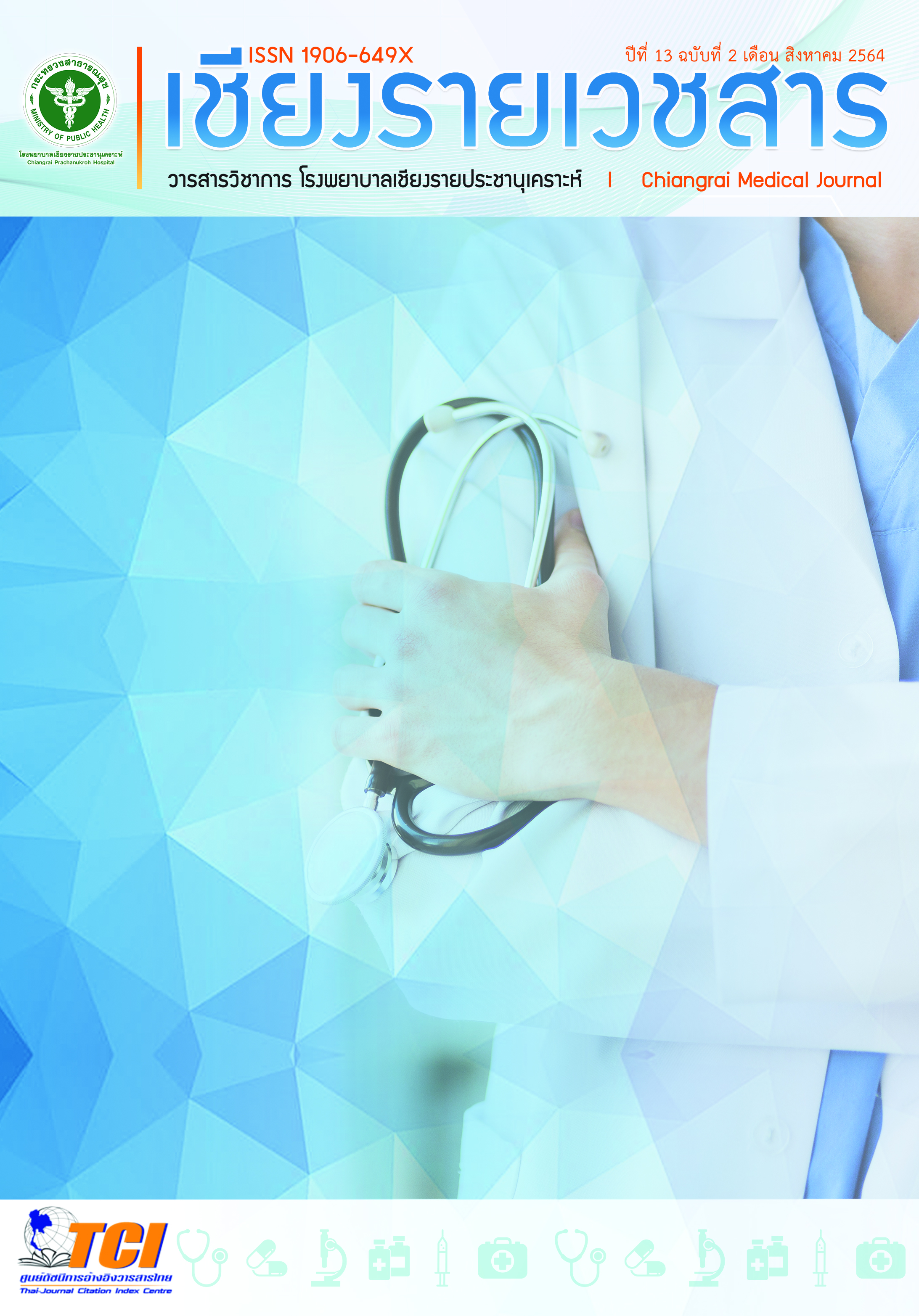อุบัติการณ์และปัจจัยเสี่ยงของการบาดเจ็บของกระดูกสันหลังส่วนคอในผู้ป่วยที่ได้รับอุบัติเหตุที่ศีรษะไม่รุนแรงโดยเอกซเรย์คอมพิวเตอร์
Main Article Content
บทคัดย่อ
ความเป็นมา
ปัจจุบันผู้ป่วยที่สงสัยว่ามีการบาดเจ็บกระดูกสันหลังส่วนคอในโรงพยาบาลเชียงรายประชานุเคราะห์จะได้รับการส่งตรวจเอกซเรย์คอมพิวเตอร์กระดูกส่วนคอเพิ่มเติมทุกราย ซึ่งอาจเป็นการส่งตรวจที่เกินความจำเป็นในผู้ป่วยที่ได้รับอุบัติเหตุที่ศีรษะไม่รุนแรง เนื่องจากการตรวจร่างกายผู้ป่วยร่วมกับประเมินปัจจัยเสี่ยงอาจสามารถประกอบในการพิจารณาแยกผู้ป่วยที่มีหรือไม่มีภาวะการบาดเจ็บของกระดูกสันหลังส่วนคอได้
วัตถุประสงค์
เพื่อศึกษาอุบัติการณ์และปัจจัยเสี่ยงของการบาดเจ็บของกระดูกสันหลังส่วนคอในผู้ป่วยที่มีการบาดเจ็บที่ศีรษะชนิดไม่รุนแรงโดยใช้เอกซเรย์คอมพิวเตอร์
วิธีการศึกษา
เป็นการศึกษาย้อนหลังโดยเก็บข้อมูลจากเวชระเบียนและภาพเอกซเรย์คอมพิวเตอร์ของผู้ป่วยที่ได้รับการตรวจเอกซเรย์คอมพิวเตอร์กระดูกสันหลังส่วนคอ ในโรงพยาบาลเชียงรายประชานุเคราะห์ตั้งแต่วันที่ 1 มกราคม 2562 – 31 ธันวาคม 2562 ประเมินภาวะบาดเจ็บของกระดูกสันหลังส่วนคอโดยเอกซเรย์คอมพิวเตอร์ รวมถึงปัจจัยเสี่ยงทางคลินิกและรังสีวิทยา เปรียบเทียบปัจจัยเสี่ยงโดย ใช้สถิติ student t-test , Wilcoxon rank sum test และ Exact probability test ตามความเหมาะสม และคำนวณความเสี่ยงที่เพิ่มขึ้นโดยใช้ logistic regression โดยกำหนดนัยสำคัญทางสถิติที่ p<0.05
ผลการศึกษา
ผู้ป่วยทั้งหมด 554 ราย พบ ภาวะบาดเจ็บของกระดูกสันหลังส่วนคอ 135 ราย (ร้อยละ 24.37) ปัจจัยที่เพิ่มความเสี่ยงต่อการบาดเจ็บกระดูกสันหลังส่วนคอได้แก่
ปัจจัยเสี่ยง
Adjusted Odds Ratio
95% CI
p-value
เพศชาย
2.14
1.29-3.68
0.002
มีกดเจ็บที่กระดูกสันหลัง
11.77
3.04-100.42
< 0.001
ไม่สามารถขยับคอได้
2.92
1.89-4.54
< 0.001
มีอาการชาหรืออ่อนแรง
4.70
2.58-8.57
< 0.001
Prevertebral soft tissue swelling
14.15
6.32-34.58
< 0.001
Vertebral fusion
3.01
1.17-7.63
0.007
Degenerative change
1.73
1.14-2.62
0.006
ไม่พบการบาดเจ็บของกระดูกสันหลัง ถ้าผู้ป่วยไม่เข้าเกณฑ์ของ NEXUS หรือ Canadian C-spine rule study
สรุปผลและข้อเสนอแนะ
ในผู้ป่วยที่มีการบาดเจ็บที่ศีรษะไม่รุนแรงและสงสัยการบาดเจ็บกระดูกสันหลังส่วนคอควรส่งตรวจเอกซเรย์คอมพิวเตอร์ส่วนคอเพิ่มเติมตามความเหมาะสมโดยพิจารณาจากปัจจัยเสี่ยง และอิงเกณฑ์ NEXUS หรือ Canadian C-spine rule study
Article Details
เอกสารอ้างอิง
Milby AH, Halpern CH, Guo W, Stein SC. Prevalence of cervical spinal injury in trauma. Neurosurg Focus. 2008;25(5):E10
Cochran WG. Sampling Techniques. 3rd ed. New York: John Wiley & Sons;1977.
Dreizin D, Letzing M, Sliker CW, Chokshi FH, Bodanapally U, Mirvis SE, et al. Multidetector CT of blunt cervical spine trauma in adults. Radiographics. 2014;34(7):1842-65.
Gehweiler JA, Duff DE, Martinez S, Miller MD, Clark WM. Fractures of the atlas vertebra. Skeletal Radiol 1976;1(2):97–102.
Anderson LD, D'Alonzo RT. Fractures of the odontoid process of the axis. J Bone Joint Surg Am.
;56(8):1663-74.
Effendi B, Roy D, Cornish B, Dussault RG, Laurin CA. Fractures of the ring of the axis: a classification based on the analysis of 131 cases. J Bone Joint Surg Br. 1981;63-B(3):319-27.
Rojas CA, Vermess D, Bertozzi JC, Whitlow J, Guidi C, Martinez CR. Normal thickness and appearance of the prevertebral soft tissues on multidetector CT. AJNR Am J Neuroradiol. 2009;30(1):136-41.
Hoffman JR, Mower WR, Wolfson AB, Todd KH, Zucker MI. Validity of a set of clinical criteria to rule out injury to the cervical spine in patients with blunt trauma. National Emergency X-Radiography Utilization Study Group. N Engl J Med. 2000;13;343(2):94-9.
Stiell IG, Wells GA, Vandemheen KL, Clement CM, Lesiuk H, De Maio VJ, et al. The Canadian C-spine rule for radiography in alert and stable trauma patients. JAMA. 2001;286(15):1841-8.
Pickett GE, Campos-Benitez M, Keller JL, Duggal N. Epidemiology of traumatic spinal cord injury in Canada. Spine (Phila Pa 1976). 2006;31(7):799-805.
Sekhon LH, Fehlings MG. Epidemiology, demographics, and pathophysiology of acute spinal cord injury. Spine (Phila Pa 1976). 2001;26(24 Suppl):S2-12.
Nuñez DB, Ahmad AA, Coin CG, LeBlang S, Becerra JL, Henry R, et al. Clearing the cervical spine in multiple trauma victims: A time-effective protocol using helical computed tomography. Emerg Radiol.
;1(6):273–8.
Lomoschitz FM, Blackmore CC, Mirza SK, Mann FA. Cervical spine injuries in patients 65 years old and older: epidemiologic analysis regarding the effects of age and injury mechanism on distribution, type, and stability of injuries. AJR Am J Roentgenol. 2002;178(3):573-7.
Theocharopoulos N, Chatzakis G, Damilakis J. Is radiography justified for the evaluation of patients presenting with cervical spine trauma?. Med Phys. 2009;36(10):4461-70.
American College of Radiology. ACR Appropriateness Criteria ® Suspected Spine Trauma. Virginia: American College of Radiology; 2012.


